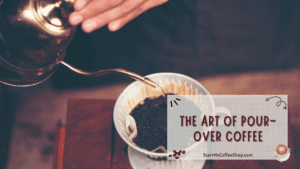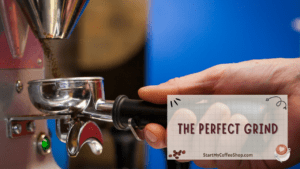For coffee lovers, the process of brewing their coffee at home is amazing. The aroma that fills the kitchen, the suspense of that first sip, and the option to experiment with various variables to produce a personalized cup of joe – all of these things contribute to the allure of home brew coffee.
To best enjoy your home brew coffee, you should explore popular and creative methods like pour-over, French press, AeroPress, and cold brew. Experiment with beans, grind sizes, water ratios, and brewing times to tailor your coffee to perfection.
The Art of Pour-Over Coffee

A steady hand and a little bit of patience are needed to make pour-over coffee, which is a time-honored technique. Hot water is poured over the ground coffee and allowed to drip through a filter into a container below. By adjusting the flow rate and the pour pattern, you can precisely regulate the brewing process and draw out certain tastes from the coffee beans.
Start with freshly roasted and freshly ground beans for the greatest pour-over coffee. The flavor profile of your brew is significantly influenced by the beans you choose. Try out various single-origin beans or blends to find the flavor that best suits your palette. Consider the grind size as well because it affects the texture and overall flavor of the coffee. Coarser grinds extract differently than finer ones.
Pour-over brewing requires precise control of the water’s temperature and ratios. To extract the best tastes, aim for water that is between 195°F and 205°F (90°C and 96°C). 1 gram of coffee to 15 grams of water is a typical ratio. However, feel free to change this ratio to your preferred level and experiment with how the flavor is affected. You’ll see the coffee bed bloom as you pour, releasing trapped gases and starting the extraction procedure.
Read more about: Online Coffee Business Plan: Brewing The Digital Blend
The Classic French Press
Many coffee lovers adore the French press, also known as the press pot, for the results it produces that is full-bodied and rich. To separate the grounds from the liquid using this procedure, coarsely ground coffee is steeped in hot water first.
Choose a dark roast or a medium-dark roast for a delicious French press experience because they can tolerate the lengthier steeping period without becoming bitter. To avoid excessive extraction and sediment in the cup, coarsely grind the beans.
The French press technique also relies heavily on water temperature. Use water that is around 200°F (93°C) or off the boil, and let the coffee steep for four minutes. Try various steeping times to achieve the perfect combination of boldness and acidity.
The Versatile AeroPress
The AeroPress is a relatively new addition to the coffee-brewing toolkit, but because of its ease of use and adaptability, it has become very popular. It produces a clear and strong cup of coffee using a mix of immersion and pressure.
Medium-roasted beans are ideal for AeroPress when it comes to coffee. With this technique, the extraction may be completed more quickly, and medium roasts provide a wonderful mix of acidity and richness.
The grind size for AeroPress is coarser than espresso, but finer than that of a French press. This equilibrium offers the best extraction and reduces the possibility of over-extraction or bitterness.
You should experiment with varied brewing times, ranging from 1 to 2 minutes, and use water that is just off the boil (about 175°F to 185°F or 80°C to 85°C). A longer brewing period promotes body and sweetness, whereas a shorter brewing period stresses brightness.
The Delight of Cold Brew
In recent years, especially during warm months, cold brew coffee has established itself as a go-to option for consumers wanting a smooth and refreshing coffee experience. With this technique, coarsely ground coffee is steeped in cold water for a long time—typically 12 to 24 hours—before the grounds are filtered out.
If you want to create a satisfying balance of tastes in your cold brew, think about selecting a medium to dark roast. Longer brewing times result in less acidic coffee that highlights the beans’ richer, smoother flavors.
In cold brew, the grind size is vital; coarser grounds prevent over-extraction and provide a clean cup. Choose a grind that is comparable to a French press.
Depending on the strength you want, experiment with different water-to-coffee ratios, which commonly range from 1:4 to 1:8. A more concentrated brew results from longer steeping durations and greater ratios, which you can then mix with milk or water to your taste.
The Importance of Freshness
No matter the home brewing technique you use, using high-quality, recently-roasted coffee beans is essential to producing a cup of coffee that is genuinely remarkable. It’s essential to spend money on freshly roasted beans from reliable sources for a wonderful coffee experience. Fresher beans maintain their natural flavors and smells, creating a delicious brew.
Consider grinding the coffee beans right before brewing to maintain their best properties. The volatile chemicals responsible for the alluring scents and flavors are preserved by grinding right before brewing. After the beans are ground, they swiftly start to lose these chemicals, resulting in a less bright cup.
The Perfect Grind

It is impossible to overestimate the importance of grind size in home-brew coffee because it is a key factor in shaping the flavors and qualities of the finished cup. For the greatest results, different brewing techniques require different grind sizes.
A medium-fine grind is necessary for pour-over coffee to achieve regulated extraction. The moderately fine grind makes it possible for hot water to permeate the coffee bed uniformly and take out the required flavors without over-extracting. This produces a cup that is well-rounded and nuanced and highlights the distinctive features of the chosen beans.
On the other hand, a coarser grind is best for the French press and AeroPress techniques. The potential of over-extraction, which can produce undesirable bitterness and a murky cup, is reduced by the larger grind particles. The coarser grind in the French press ensures that the metal mesh filter properly separates the coffee grounds from the brew, while the shorter steeping time in the AeroPress works in tandem with the coarser grind to produce a clear and powerful cup.
A particularly coarse grind is necessary for creating a smooth and energizing cold brew. If the grind is too fine, the prolonged steeping time of cold brew can easily result in bitterness and over-extraction. A slower extraction process, which captures the mild, mellow tastes of the coffee beans and keeps out any harsh or disagreeable overtones, is made possible by utilizing an extra coarse grind.
Read more about: Online Coffee Shop Business Plan: The Virtual Barista’s Playbook
Water: The Unsung Hero
Water quality is a crucial but frequently disregarded element that can have a significant impact on the final product of your home-brewed coffee. It is essential to consider the source and characteristics of the water used in the brewing process because they have a major impact on the flavor and scent of the coffee.
When brewing your coffee, choose filtered or bottled water for the finest results. The natural qualities of the coffee may be severely affected by pollutants like chlorine, salts, or other substances in tap water. A clearer palate for your coffee guarantees that the intricacies of the beans may come through without any off-flavors. Filtered or bottled water can help with this.
In addition to purity, water temperature is another important factor in the brewing process. The flavor and general balance of the coffee can be substantially impacted by a few degrees of hot or cold. Coffee should be brewed at a temperature between 195°F and 205°F (90°C and 96°C). A bitter and harsh coffee could arise from over-extraction caused by too-hot water. On the other hand, too-cold water can cause under-extraction, which will produce a weak and uninteresting cup.
Maintaining the integrity of the coffee’s taste also depends on maintaining consistency in water temperature. You can obtain the ideal water temperature consistently by using a thermometer or an electric kettle with temperature control, delivering a dependable and pleasurable coffee experience with each brew.
Experimentation and Personalization
Coffee brewing at home is a pleasant opportunity for discovery and individualization, as it gives you the option to adjust the flavor of your beverage to suit your specific preferences in terms of aroma and flavor profile. Embrace the wonder that is this process, since the real magic of home brewing lies in tinkering with the various variables and testing different combinations of ingredients.
Experimenting with different types of coffee beans, each of which has a unique flavor profile, is a good place to start. Discover the nuances that speak to your palate by experimenting with beans of a single origin, as well as a variety of blends, ranging from light to dark roasts. Don’t be afraid to go out and try different coffee origins; each one has a fascinating history that comes through in the cup.
Another important factor that enables you to fine-tune your brew is the grind size of the coffee beans. Try the coffee with the grind set at various levels, from very coarse to very fine, and note how the adjustment affects the taste, body, and acidity of the beverage. A coarser grind results in a flavor that is more mellow and smooth, while a finer grind results in a stronger cup of coffee.
Both the amount of water used and the length of time it takes to brew are important variables to experiment with. Experiment with different proportions of water to coffee to determine what level of intensity you prefer in your cup of coffee. This will help you achieve the ideal equilibrium between boldness and smoothness. You should also experiment with different brewing times to observe how the coffee’s flavor and aroma change as a result.
If you’re just starting in the world of home brewing, one piece of advice I can give you is to not be hesitant to attempt methods that are outside of your comfort zone. You may give your coffee a more interesting flavor by including unusual ingredients or spices in it, such as cinnamon or cardamom. This will give it an unusual twist. If you want to personalize your coffee even further, you might want to experiment with different kinds of milk substitutes or sweeteners.
It is important to keep in mind that home brewing does not adhere to any strict guidelines; rather, it is an adventure in self-discovery and exploration. Every time you make beer, there is a new chance to learn, modify, and improve your brewing procedures to accommodate your ever-changing preferences.
Frequently Asked Questions

What is the most effective way to make coffee at home?
Personal preferences ultimately determine the best way to prepare coffee at home. Pour-over, French press, AeroPress, and cold brew are popular options among coffee lovers. It’s recommended to experiment with each method to see which one best suits your preferences because each one has distinctive qualities.
What factors should I consider while selecting coffee beans for home brewing?
A satisfying home brew experience depends on selecting the correct coffee beans. Consider your preferred flavor profile when looking for freshly roasted beans from reliable providers. Medium-roasted beans are a wonderful option for a flavor that is well-balanced, while dark roasts provide a richer, more robust flavor. To choose your favorite, try either single-origin beans or mixes.
What grind size should I employ for various brewing techniques?
To achieve the appropriate flavors in your home-brewed coffee, the grind size is essential. Use a medium-fine grind for pour-over to manage the extraction. For French press and AeroPress, a coarser grind is excellent to prevent over-extraction. In contrast, a more coarse grind is necessary for cold brew to avoid bitterness throughout the prolonged steeping period. Depending on your preferred brewing method and flavor preferences, adjust the ground size.
To learn more on how to start your own coffee shop, check out my startup documents here.
Disclaimer: The information provided by StartMyCoffeeShop.com (“The Site”) is for general informational purposes only. All information on the Site is provided in good faith. However, we make no representation or warranty of any kind, express or implied, regarding the accuracy, adequacy, validity, reliability, availability, or completeness of any information on the Site. Under no circumstance shall we have any liability to you for any loss or damage of any kind incurred as a result of the use of the Site or Reliance on any information provided on the Site. Your use of the Site and reliance on any information on the Site is solely at your own risk. This blog post is for educational purposes only and does not constitute legal advice. Please consult a legal expert to address your specific needs. Terms and Conditions. (https://startmycoffeeshop.com/terms-and-conditions/)

Hi! I’m Shawn Chun
My adventure in coffee began when I first launched my first coffee shop back in the early 2000s. I had to figure out so many things on my own and to make it worse within 2 years of opening two large corporate coffee chains moved in just blocks away from me!
As I saw smaller and even some larger coffee shops in the neighborhood slowly lose customers to these giant coffee chains and slowly close up shop, I knew that I had to start getting creative…or go out of business.
I (like you may be) knew the coffee industry well. I could make the best latte art around and the foam on my caps was the fluffiest you have ever seen. I even had the best state-of-the-art 2 group digital Nuova Simonelli machine money could buy. But I knew that these things alone would not be enough to lure customers away from the name brand established coffee shops.
Eventually, through lots of trial and error as well as perseverance and creativity I did find a way to not only survive but also thrive in the coffee/espresso industry even while those corporate coffee chains stayed put. During those years I learned to adapt and always faced new challenges. It was not always easy, however, in the end, I was the sole survivor independent coffee shop within a 10-mile radius of my location. Just two corporate coffee chains and I were left after that year. All told the corporate coffee chains took down over 15 small independent coffee shops and kiosks and I was the last one standing and thriving.
Along the years I meet others with the same passion for coffee and I quickly learned that it is not only “how good a barista is” that makes a coffee shop successful, but the business side of coffee as well.
Hence why I started this website you are on now. To provide the tools and resources for up and coming coffee shop owners to gain that vital insight and knowledge on how to start a coffee shop successfully.
Stick around, browse through my helpful blog and resources and enjoy your stay! With lots of LATTE LOVE!
Shawn







